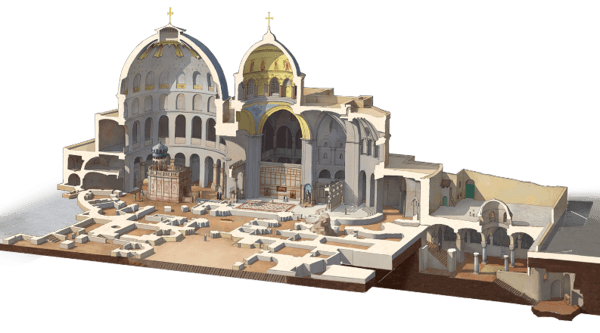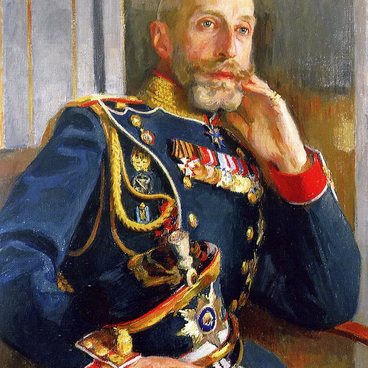The icon is produced in the technique of chromolithography, multi-colored printing from a flat stone. The technique was highly popular in the late 19th century. At the time, monasteries usually had their own printing shops producing large numbers of icon prints. Bright-colored icons were in high demand.
Icon. View of the Church of the Holy Sepulcher
Creation period
1890s
Dimensions
32x34,5 cm
32x24.5 cm
32x24.5 cm
Technique
Chromolithography
1
Open in app#1
View of the Church of the Holy Sepulcher
#2
#5
Jerusalem Church of Christ’s Resurrection
This museum exhibit was created in 1890 in Jerusalem. The kuvukliya, a marble chapel in the Jerusalem Church of Christ’s Resurrection occupies the icon’s central part. Pilgrims from all over the world came here to see one of the major holy relics of Christianity, Lord’s Tomb. The temple was built on the site assumed to be Jesus Christ’s burial place. It is presently open to pilgrims; the architectural site includes the Golgotha, location of crucifixion, and other objects.
#6
The central image is flanked by miniature scenes elaborating on the central theme known in iconography as frames. The frames are usually of rectangular shape.
The miniature in the icon’s upper left-hand corner shows Saints Constantine and Helena, Roman Emperor and his mother who lived in the 4th century AD. The miniature in the upper right-hand corner is the holy place of Golgotha. The Gospel mentions that the site (the rock or the hill) was located close to the city. The name ‘Golgotha’ in literary translation means ‘skull’. Some historians attribute the origin of the name to the Jerusalem’s ancient tradition of piling up skulls on execution sites. According to another legend, the Golgotha was the place of burial of the first man on earth, Adam.
The miniature in the icon’s upper left-hand corner shows Saints Constantine and Helena, Roman Emperor and his mother who lived in the 4th century AD. The miniature in the upper right-hand corner is the holy place of Golgotha. The Gospel mentions that the site (the rock or the hill) was located close to the city. The name ‘Golgotha’ in literary translation means ‘skull’. Some historians attribute the origin of the name to the Jerusalem’s ancient tradition of piling up skulls on execution sites. According to another legend, the Golgotha was the place of burial of the first man on earth, Adam.
#8
The miniature showing Myrrh-Bearing Women is placed in the icon’s bottom left-hand corner. It shows Christ’s appearance to the three women who were the first to come to his sepulchral cave in order to mourn over the body and anoint the body with sweet spices as prescribed by the Jewish ritual.
The second miniature in the icon’s bottom depicts Mary Magdalene (Noli Me Tangere). Saint Mary Magdalene, Christ’s follower cured by him of evil spirits witnessed crucifixion with the others.
#9
According to the Gospel, Maria came to the funeral cave together with the myrrh-bearing women. Finding no body she decided that it had been stolen and shed bitter tears. Then she was the first to see Jesus whom she took for a gardener. Christ asked her to let his disciples know about his resurrection.
#10
The third miniature depicts the Shroud. That is a length of cloth wrapped around the body of Christ before it was placed in a tomb. The name “shroud” also applies to a rectangular piece of cloth bearing the image of Christ’s deceased body. The Shroud is taken out on Good Friday before the Passover for believers to see and venerate.
#11
Sverdlovsk State Regional Ethnography Museum
read morehide
00:00
00:00
1x
Icon. View of the Church of the Holy Sepulcher
Creation period
1890s
Dimensions
32x34,5 cm
32x24.5 cm
32x24.5 cm
Technique
Chromolithography
1
Open in app
Share




